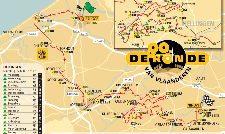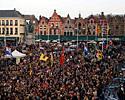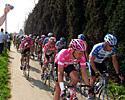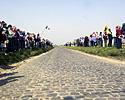
Recently on Cyclingnews.com |
90th Ronde van Vlaanderen - PT
Belgium, April 2, 2006
Flat then frantic - the Ronde parcours
By Jeff Jones
 |
This year's Ronde Van Vlaanderen parcours is as hard on paper as most of them are. For starters, there's the distance of 258 km, which is a big distance to race a bike over. Add in cobbles - 20 km of them, all up - and climbs, of which there are 17 this year, narrow, twisting, bumpy roads, a strong wind, and probable rain shows, and you have a real hard man's race. It's not a race for a climber, but someone who can produce a lot of power in short bursts, and still have enough at the end to go hard in the final 20 km.
The Ronde starts in Brugge, near the west coast of Flanders, and one of Belgium's top tourist destinations. It huge, cobbled Grote Markt provides enough space to fit the riders, the presentation stage, and a hell of a lot of people. And you can guarantee a big crowd at Vlaanderen's mooiste.
After the gun goes off at 9:40am, the riders cruise out of Brugge to Sint-Pieters, where the race officially starts at 10:00am. Then it's almost due west out to the seaside at Oostende, before the course turns southeast towards the Vlaamse Ardennen. By this stage, the first breakaway of the day should be established, although anything can happen in the Ronde when there's a stiff crosswind blowing. After passing Ichtegem (km 38), which is the official town of the Ronde, the route goes through Torhout, Lichtervelde, Roeselare, Izegem and Kortrijk (km 82).

|
After 100 km, the race crosses into East Flanders, and the wind should be more at the riders' backs now. The first cobbled section comes at Wannegem (km 114), and although it's only 400m, it's a taste of the 20 km of bone jarring that is to come. A more serious cobbled section comes at Doorne, just outside Oudenaarde, after 117 km, then it's onto Zottegem and the Paddestraat at Velzeke (km 137). Another 2400m of cobbles greets the riders here, in addition to a sort of Roman tunnel of horrors, created by the cartoonist Nesten, who does interesting caricatures of the riders each year.
The first of 17 climbs hits after 145 km, and although just 325m, the Molenberg is no easy task. There's nearly always a sprint to get to the foot of the climb first, then a sharp turn onto some sharper cobbles, winding up past the mill at 9.9% gradient. The fun really starts now, with a 3000m section of cobbles at Mater-Kerkgate (km 150), followed immediately by the Wolvenberg, the second climb of the day. It's 800m long and averages 6.3%, with a maximum of 19% - but at least it's asphalt.

|
The riders descend on 1200m of cobbles known as the Kattenberg, but they're not too dangerous, and it's a safe descent. There is a bit of respite as the race keeps heading west to Kluisbergen, and the third climb, the Oude Kwaremont after 174 km. This is 2200m long, mostly cobbled, and while it only averages 4.2%, it's often enough to break a peloton into pieces. There are still 85 km to go, but the selection will have started. After the Kwaremont, it's onto the Paterberg, a tough 400m cobbled climb at 12.5%, with a leg-snapping maximum of 20%. A few kilometres later is probably the hardest berg in the Ronde, the Koppenberg: 600m of cobbles, averaging 11.6% with a maximum of 22%. Both these climbs are lethal in the wet, and with the recent rain, it looks like many riders will be walking up them. A hint: don't get out of the saddle.
The hills keep coming now, and after the Steenbeekdries (km 190, 820m cobbled at 7.6%), it's onto the Taaienberg (km 194, 800m cobbled at 7.1%), Eikenberg (km 197, 1200m cobbled at 5%), Boigneberg (km 201, 1000m asphalt at 5.2%), Foreest (km 208, 680m asphalt at 8.4%) and Steenberg (km 211, 820m asphalt at 7.6%). All of them aren't difficult by themselves, but their succession (combined with everything else in the Ronde) gradually wears the group down.

|
The last significant 'flat' cobbled section is the Haaghoek, 2000m of down and up, leading straight onto climb 12, the Leberg (km 216, 700m of asphalt at 6.1%). Then it's down into Michelbeke and onto the Berendries, a higher climb than most, averaging 7.2% for 900m. There are 37 km to go by now, and the big guns are usually firing on the Berendries. There is a fast descent into Brakel, before the Valkenberg (km 226, 875m of asphalt at 6.1%) and the Tenbosse (450m at 6.9%). The latter is actually one of the easiest climbs in the race, but often, critical breaks go on it.
A longish, tailwind descent into Parike follows, then up over a small hill before the gentle false flat down into Geraardsbergen (km 242). Here, the riders meet the penultimate climb, the mighty Muur-Kapelmuur. It's 1000m at 9.2%, with the last 700m cobbled and hitting 20% in parts. If anyone's got the legs, it's here they will attack. The next part is tail/crosswind, mostly downhill, until the riders reach the last climb, the Bosberg. This is 1350m of cobbles, but at a gentler 5%. It's still possible to make a winning attack here, but not as easy to make a difference as it is on the Muur.
Once over the top, there are 12 km to go before the finish in Ninove-Meerbeke. It's likely to be a tailwind here, which, combined with the slight descent, will suit a solo breakaway. It's all wide roads now, and the finish is on the Hallebaan, with a slight uphill sprint. Listen to the roar of the crowd if a Flemish rider comes through to win the Ronde...or the muted applause if a foreigner manages to pull of a win in Vlaanderen's mooiste.
